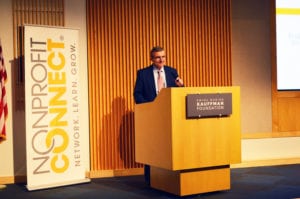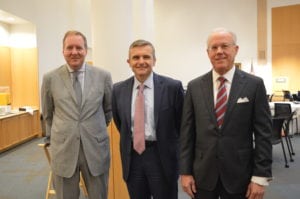
Dr. Pasic reminded us that essentially, leadership is fundraising, and asked the poignant question, “If a leader isn’t fundraising, is he really a leader?” Dr. Pasic pointed out leadership and fundraising both involve 1) building relationships, 2) engaging, asking and recognizing and 3) creating vision and buy-in. Check out Dr. Pasic’s blog on this very topic.
Key highlights from Dr. Pasic’s presentation included some great examples of people putting research into action:
- Jane Chu, PhD, Chairman of the National Endowment for the Arts (Rockhurst grad, Lilly Family School of Philanthropy alum and previous director of the Kauffman Center for the Performing Arts Center) and how she used research to illustrate the impact of the arts and cultural industries on the nation’s gross domestic product.
- Giving USA: The Annual Report on Philanthropy, measures the financial scope of philanthropy in the U.S. and is fundamental to fundraising. The seminal report on charitable giving, Giving USA is the longest-running and most comprehensive evaluation of philanthropic trends in the United States. Giving USA is published by the Giving USA Foundation and is researched and written by the Indiana University Lilly Family School of Philanthropy.
Dr. Pasic also pointed out that in addition to utilizing research for evaluation or benchmarking purposes, we can also use research to help identify impact, areas needing funding and other issues in our sector, such as recruiting and retaining talent.
Dr. Pasic also address some of the “hot topics” in fundraising research now, such as Crowdfunding, Donor-Advised Funds and disaster giving. Crowdfunding is on the rise, and in 2015, $34.44 billion was generated in Crowdfunding, with $2.8 billion of that total raised for formal charitable purposes.
The prevalence of Donor-Advised Funds is increasing as well, both in the number of funds and the total assets held within them: in 2006, there were 140,000 DAFs holding assets of $33.6 billion. By 2016, those figures had grown to 269,000 and $78.6 billion respectively. And in 2015, Fidelity Charitable Gift Fund unseated United Way Worldwide as the largest fundraising charity, having collected $4.6 billion. And three of the Top 10 largest fundraising charities on the list are commercial DAFs: Fidelity Charitable Gift Fund, Schwab Charitable Fund and National Christian Foundation. More than half of all DAFs are held in commercial funds and this hot topic is raising questions about their usage: what are the benefits versus the costs to society and the nonprofit sector? What is the overall impact? Are DAFS displacing other forms of giving?
The Lilly Family School of Philanthropy has been tracking disaster giving since the attacks of 9/11. Typically following a disaster, we see a sharp uptick in donations in the first six weeks, with continued moderate growth through six months then finally leveling out. Celebrities are very prominent in disaster giving (J.J. Watt raised more than $30 million for Hurricane Harvey relief) and the key element in disaster giving is mass participation. And in times of disaster, we overcome our differences and unite as one force to help those in need.
Dr. Pasic discussed the different types of research:
- quantitative studies (such as Giving USA, Million Dollar List and The Salvation Army Human Needs Index)
- experiments (take us away from our “rules of thumb” and comfort zones, but help us discover more effective ways of doing things)
- humanities (qualitative exploration – such as the Smithsonian Exhibit on Philanthropy (Giving in America is a permanent exhibit that looks at the historical role of philanthropy in shaping the United States)
- studies of the profession (gender composition of the field, diversity in the field and other issues like compensation and tenure
- public policy (tax reform, regulations, ethical guidelines for dealing with grateful patients and better educating legislators about our field)
Research asks the questions, in a variety of ways, “Why do things fail? Why do things succeed?” Bottom line, research helps us cultivate judgement, create communities of discovery and develop leaders – all of which will help us strengthen philanthropy and our world.



